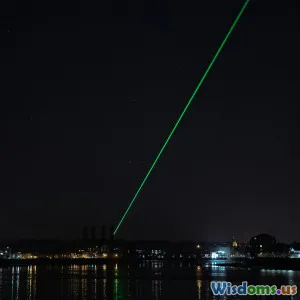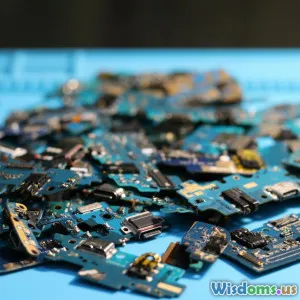
Space Technology and Its Military Applications
8 min read Explore how space technology is revolutionizing military defense and warfare strategies worldwide. (0 Reviews)
Space Technology and Its Military Applications: Shaping the Future of Warfare
Space – once the final frontier for exploration – is becoming the next critical domain for military supremacy. With the increasing reliance on satellites and orbital platforms, space technology is not just about exploration but has evolved as an essential element in modern defense systems. This article unpacks the nuances of space technology's intersection with military applications, presenting a thorough analysis of its current use and future potential.
Introduction: The Strategic Value of Space in Modern Defense
The militarization of space is no longer a speculative fiction theme; it is a rapidly unfolding reality. The ability to utilize space for military advantage has caught the attention of global superpowers, igniting competition for control over orbits and satellite capabilities. Why? Because dominion in space translates to strategic superiority on Earth.
With key military operations depending on global positioning, reconnaissance, and real-time communication, satellites and space-based systems offer unprecedented capabilities to modern defense forces. The evolving landscape of militarized space simultaneously opens new avenues for surveillance, communication, and defense — pushing the boundaries of traditional warfare.
The Pillars of Military Space Technology
1. Satellite Reconnaissance and Surveillance
Arguably the backbone of space-based military operations is satellite reconnaissance. Since the Cold War era, satellites have been indispensable for intelligence gathering.
-
Example: The US Global Positioning System (GPS) not only enables accurate navigation but functions as a hardened, secure network for military command and control. The National Reconnaissance Office (NRO) operates highly classified reconnaissance satellites that provide detailed imagery and electronic intelligence for battlefield awareness.
-
Advancements: Modern surveillance satellites use synthetic aperture radar (SAR) allowing imaging regardless of weather or lighting conditions. This continuous, real-time surveillance capability empowers military forces with enhanced situational awareness and strategic planning advantage.
2. Space-Based Communication Systems
Secure and reliable communication is a non-negotiable element of any military operation. Space technologies enable seamless, global communication networks.
-
Real-World Impact: The Wideband Global SATCOM system, used by the US military, offers high-capacity communication channels essential for transmitting data, voice, and video worldwide.
-
Strategic Importance: By relying on space communication, militaries overcome terrestrial geographical barriers and interference challenges, maintaining operational command chains even in remote or hostile environments.
3. Missile Early Warning and Defense Systems
Satellites equipped with infrared sensors act as sentinels, detecting missile launches in their incipient phases.
-
Fact: The US Space-Based Infrared System (SBIRS) provides real-time missile launch detections, reducing the time to respond and intercept threats.
-
Emerging Technologies: Anti-satellite (ASAT) weapons and space-based missile defense platforms are gaining traction. Nations are investing heavily in space-capable interceptors to neutralize both ballistic missiles and adversarial satellites, reflecting a new era in layered defense strategy.
4. Precision Guided Munitions and Targeting
Space technology enhances missile guidance accuracy through satellite navigation. This is pivotal for modern 'smart' weapons systems.
-
Example: The JDAM (Joint Direct Attack Munition) uses GPS guidance for pinpoint targeting, which minimizes collateral damage and maximizes strategic efficacy.
-
Future Developments: Integration of artificial intelligence with space data could yield autonomous targeting systems with unparalleled precision and adaptive tactics on the battlefield.
Emerging Innovations and Their Military Implications
Space-Based Laser Weapons
Directed energy weapons, notably lasers installed on satellites, are being researched for their capability to disable enemy satellites or incoming missiles without traditional explosive force.
- Research Insights: The US Air Force’s Tactical Boost Phase Intercept program experiments with lasers capable of neutralizing missile threats during boost phase, offering early and effective missile defense.
Autonomous Spacecraft and Satellite Swarms
Miniaturized satellites operating in swarms can provide redundancy and resilience in military space operations.
-
Benefit: Distributed networks of small satellites can conduct electronic warfare, surveillance, and communication while complicating enemy countermeasures.
-
Example: DARPA’s 'Kaiju' program explores swarm tactics to overwhelm adversaries’ space assets undermining their operational capability.
Cybersecurity Challenges in Space
With growing dependence on space systems, protecting satellites and space infrastructure from cyber-attacks is paramount.
-
Real-World Incident: The 2020 cyber-attack on a satellite communications provider exemplifies vulnerabilities in this domain.
-
Military Response: Space assets require sophisticated cyber defense mechanisms to safeguard data integrity and command links essential for battle readiness.
Geopolitical and Ethical Dimensions
The militarization of space introduces complex geopolitical tensions. Countries like China, Russia, and the USA are actively expanding their space military capabilities, raising concerns about potential arms races beyond Earth’s atmosphere.
-
Treaties: The 1967 Outer Space Treaty prohibits placement of weapons of mass destruction in space but does not clearly restrict conventional weapons or defensive systems.
-
Diplomatic Outlook: Calls for international regulation are growing, aiming to prevent conflict spillovers into space and to establish norms for peaceful military use.
Conclusion: The Final Frontier of Warfare is Now
Space technology’s impact on military applications is unprecedented, redefining the concept of engagement zones far beyond terrestrial limits. Satellites and orbital platforms underpin modern defense mechanisms from surveillance through secure communication to missile defense.
As innovations like laser weapons and autonomous satellite swarms evolve, space will emerge as a decisive theater for future conflicts. The imperative is clear for nations and militaries: securing space supremacy is not just an option but a strategic necessity.
Meanwhile, balancing technological progress with ethical and geopolitical stability will define how humanity leverages this vast expanse – potentially turning the cosmos into not just a battlefield but an arena for cooperative security and peace.
References
- National Reconnaissance Office. (2022). Millstone satellite system operation overview.
- U.S. Air Force Research Lab. (2021). Tactical Boost Phase Intercept capabilities.
- Space Foundation. (2023). The 2023 Space Report: Military and Intelligence Applications.
- Outer Space Treaty, United Nations, 1967.
Rate the Post
User Reviews
Other posts in Directed Energy Weapons
Popular Posts


















